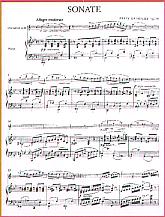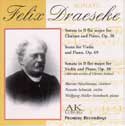Felix Draeseke: Sonata in B Flat Major for Clarinet and Piano, Op. 38
SONATA IN B FLAT MAJOR FOR CLARINET AND PIANO, Op. 38 1st Movement: Allegro moderato Draeseke's Sonata in B flat major for Clarinet and Piano, Op. 38 was written at a highpoint of the composer's career, within the year which saw the appearance of his Symphonia Tragica and the Easter Scene from Goethe's Faust. Ironically, publication of these three works followed in reverse order of composition, so that the clarinet sonata has an earlier opus number than the Goethe cantata (Op. 39) and the symphony (Op. 40). In 1887 the clarinetist did not have a large repertoire of major works by major composers in the category of duo-sonata. The sonatas of Brahms, Reger and Saint-Saens were well in the future, so it is not without justification to claim Draeseke's effort as the first major clarinet sonata of the 19th century. When one considers the contributions of Weber, Spohr, and Gade one realizes that their works for clarinet and piano fall outside the category of duo-sonata, and reveal themselves as collections of genre pieces, potpourris, or theme and variations. It is difficult to believe that Draeseke's clarinet sonata has had to wait until the 1999 release as its first recording, since it was considered repertoire at least until the 1920s and hasn't lacked performances since then: there is no doubt that it has been the most frequently performed of the composers duo sonatas it is also the only work of Draeseke which exists in more than one edition on today's market, that of Wollenweber (Munich, Germany) and that by Amadeus (Winterthur, Switzerland) - the one by Wollenweber lacks the alternate violin version. In preparing the sonata for this recording, Wolfgang Müller-Steinbach undertook exhaustive comparison of the printed editions with Draeseke's own corrected edition housed in the Coburg Landesbibliothek and found over three hundred differences. Admittedly most of them are extremely minor and do not affect the actual music, but there are seventy-one instances that should be taken into consideration for a forthcoming critical edition: some of them have been taken into consideration by the pianist for the recordings on AK/Coburg. Draeseke completed his clarinet sonata on the 22nd of May, 1887, and dedicated it to his colleague at the Dresden Conservatory, Friedrich Demnitz, who was also the first chair clarinetist in the Dresden Hofkapelle (today's Staatskapelle). The work sounds deceptively easy and uncomplicated, but it has quite a few virtuosic demands and is a classic of compositional sophistication.
The second movement, Adagio ma non troppo (E-flat major, 3/4), is another of the wonderful examples of Draeseke's understanding of "unendliche Melodie", a movement which truly extends the melodic elements of limited thematic components during its chromatic course, allowing a kaleidoscopic refraction of its lyrical whole. Looking at the score for the first time one might claim the movement to be simply rhapsodic, but "rhapsodic" implies a certain lack of disciplined formal gestures. Nothing could be further from the truth. When all is taken into consideration, the movement may be seen to be a type of slow rondo. The theme with which it begins seems vaguely related to the first theme of the preceding movement, particularly from the standpoint of retrograde motion. Presented by the piano it is answered in a similarly diatonic manner, with extension, by the clarinet: the first section of this movement remains close to the home key. A second theme (and section) arrives at the marking espressivo dolce (B-flat major) and is developed until the main theme returns in glorious elaboration in the piano: E-fiat major - G minor - B-flat major - D minor. A cadenza-like passage for the clarinet (dolce cantabile) marked by triplets leads to a new and contrasting section which acts as a bridge to a reinstatement of the opening of the movement, this time with majestic proclamations, which subside into an extended coda, itself bi-sectional, the first part of which is transitional in nature, and the second of which presents a final reminiscence of the opening motive before the movement's related conclusion.
Of all the movements of the sonata, the rondo-finale (Allegro con brio, 4/4) makes the heaviest demands on the players. It opens with a tempestuous unison passage for the two instruments which leads to the presentation of the rondo theme by the clarinet. A transitional passage for the clarinet conjures memories of Weber's bravura writing for the instrument as the music moves to a contrasting episode featuring some tricky rhythmic motives and important use of grace notes (scherzando). Rapid figurations lead to a repeat of the opening and similar rapid figurations act as transition to a C section (a tempo, meno mosso, molto espressivo) in which triplet motion takes over, exposing a lyrical episode of exceptional beauty. The rondo theme returns almost reluctantly to reintroduce the A section, with B following as in the opening. Where one expects A to return with a coda, Draeseke instead provides recall of the opening theme of the first movement, thereby lending an aspect of cyclical form (piu lento, tempo della prima parse). The A section does return for both instruments, with high trills of the clarinet in the final measures lending extra brilliance and tension. |
|
| Draeseke's Sonata in B flat major for Clarinet and Piano, Op. 38 on CD: | |
|
Felix Draeseke: Clarinet Sonata in B flat op 38; Scene for Violin & Piano op 69; Violin Sonata in B flat op 38; Nanette Schmidt [violin], Martin Nitschmann [clarinet], Wolfgang Müller-Steinbach [piano] |
|
[Chamber Music] [Orchestral Music] [Keyboard Music] [Listen: mp3 - Real Audio] [Top]
© All contents copyright by the International Draeseke Society
 The first movement, Allegro moderato (B-flat major, 4/4) begins with a theme somewhat similar in contour to those which open the Quintet in B-Flat major for Horn, Piano and String Trio, Op.48 and the Cello Sonata in D major, Op. 11. Erich Roeder, in the second volume of his two volume biographical study of Draeseke, maintains that the theme is a quote from the composer's song Von fern die Uhren schlagen (The Clocks ' Resound from Afar), Op. 26, No. 5 - unfortunately Op, 26, No. 5 is a setting of Die Stelle am Fliederbaum (That Place on the Lilac Tree) by Friedrich de la Motte-Fouque. Be that as it may, the eight measure main theme brings the listener to a world of pastoral encounter: Roeder insists that the first four measures conjure the manner of Richard Strauss and cites the sequence of notes d, f, b-flat, c. c#, d, which lead to a flowing motion as support for his claim. During the exposition of this opening theme Draeseke employs a characteristic harmonic surprise, namely a sudden and effective route through E-flat minor, which ultimately leads to a cadence in F major, in which tonality the second theme is presented, succinctly elaborated and provided with transitional material to lead to the obligatory repeat of the exposition. A somewhat truncated development sector begins with a minor mode presentation of the main theme. A sequence of chromatic elements returns the second theme and after brief interplay the instruments proceed via D major to the home key of B-flat and the recapitulation. Over a basso ostinado on F, the music gradually subsides: a lyrical cadenza for clarinet leads to the coda, a tempo tranquillo, lento.
The first movement, Allegro moderato (B-flat major, 4/4) begins with a theme somewhat similar in contour to those which open the Quintet in B-Flat major for Horn, Piano and String Trio, Op.48 and the Cello Sonata in D major, Op. 11. Erich Roeder, in the second volume of his two volume biographical study of Draeseke, maintains that the theme is a quote from the composer's song Von fern die Uhren schlagen (The Clocks ' Resound from Afar), Op. 26, No. 5 - unfortunately Op, 26, No. 5 is a setting of Die Stelle am Fliederbaum (That Place on the Lilac Tree) by Friedrich de la Motte-Fouque. Be that as it may, the eight measure main theme brings the listener to a world of pastoral encounter: Roeder insists that the first four measures conjure the manner of Richard Strauss and cites the sequence of notes d, f, b-flat, c. c#, d, which lead to a flowing motion as support for his claim. During the exposition of this opening theme Draeseke employs a characteristic harmonic surprise, namely a sudden and effective route through E-flat minor, which ultimately leads to a cadence in F major, in which tonality the second theme is presented, succinctly elaborated and provided with transitional material to lead to the obligatory repeat of the exposition. A somewhat truncated development sector begins with a minor mode presentation of the main theme. A sequence of chromatic elements returns the second theme and after brief interplay the instruments proceed via D major to the home key of B-flat and the recapitulation. Over a basso ostinado on F, the music gradually subsides: a lyrical cadenza for clarinet leads to the coda, a tempo tranquillo, lento. The third movement Scherzo (Allegro molto vivace; Presto, 3/4) returns the listener to the home key of the sonata, B-flat major. It is a whirlwind of a piece, uncomplicated from a formal standpoint and a perfect intermezzo between the expansive slow movement and the virtuosic rondo-finale. Erich Roeder misidentifies the tonality of the Scherzo as C major (he may have been considering the clarinet part) and fails to take note that the ensuing trio section (Un poco piu lento, 3/4) retains the key of B-fiat and, due to the steady pulse of the piano ostinato motive, does not stray far from that key. The obligatory repeat of the scherzo proper concludes with extended recall of elements from the trio section before the clarinet exits, accelerando-presto, to the accompaniment of two conclusive chords on the piano.
The third movement Scherzo (Allegro molto vivace; Presto, 3/4) returns the listener to the home key of the sonata, B-flat major. It is a whirlwind of a piece, uncomplicated from a formal standpoint and a perfect intermezzo between the expansive slow movement and the virtuosic rondo-finale. Erich Roeder misidentifies the tonality of the Scherzo as C major (he may have been considering the clarinet part) and fails to take note that the ensuing trio section (Un poco piu lento, 3/4) retains the key of B-fiat and, due to the steady pulse of the piano ostinato motive, does not stray far from that key. The obligatory repeat of the scherzo proper concludes with extended recall of elements from the trio section before the clarinet exits, accelerando-presto, to the accompaniment of two conclusive chords on the piano.